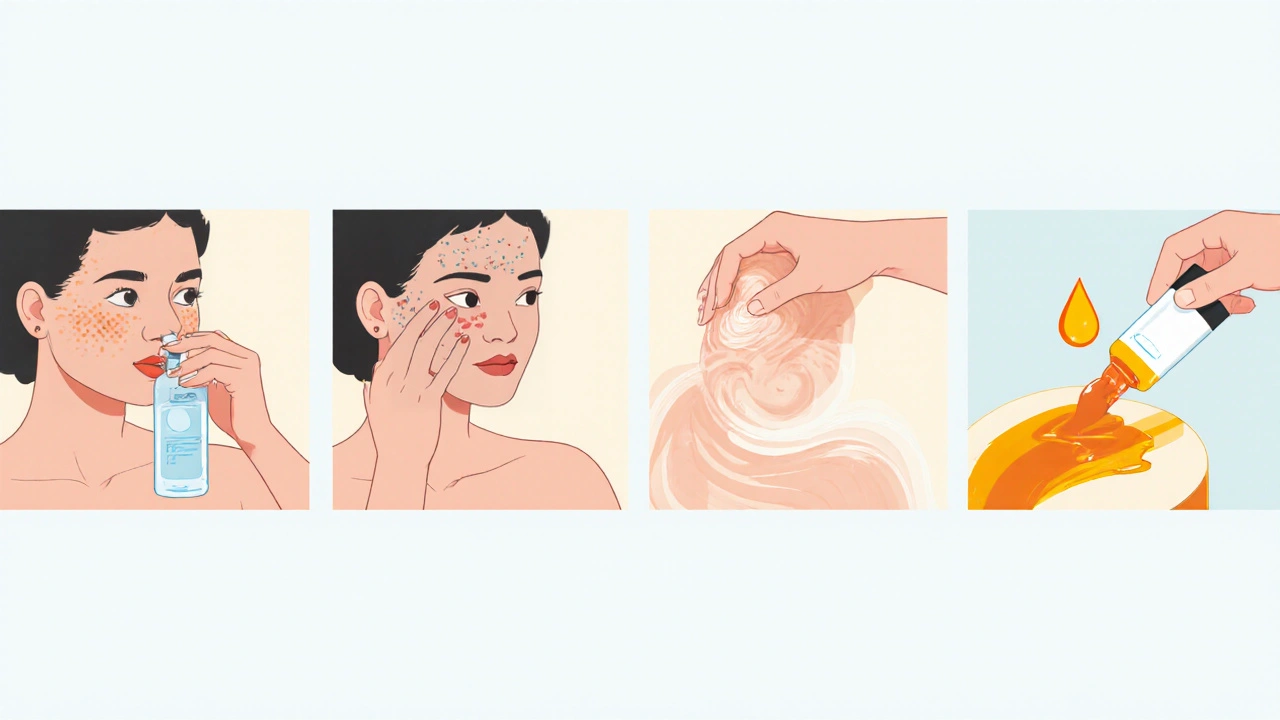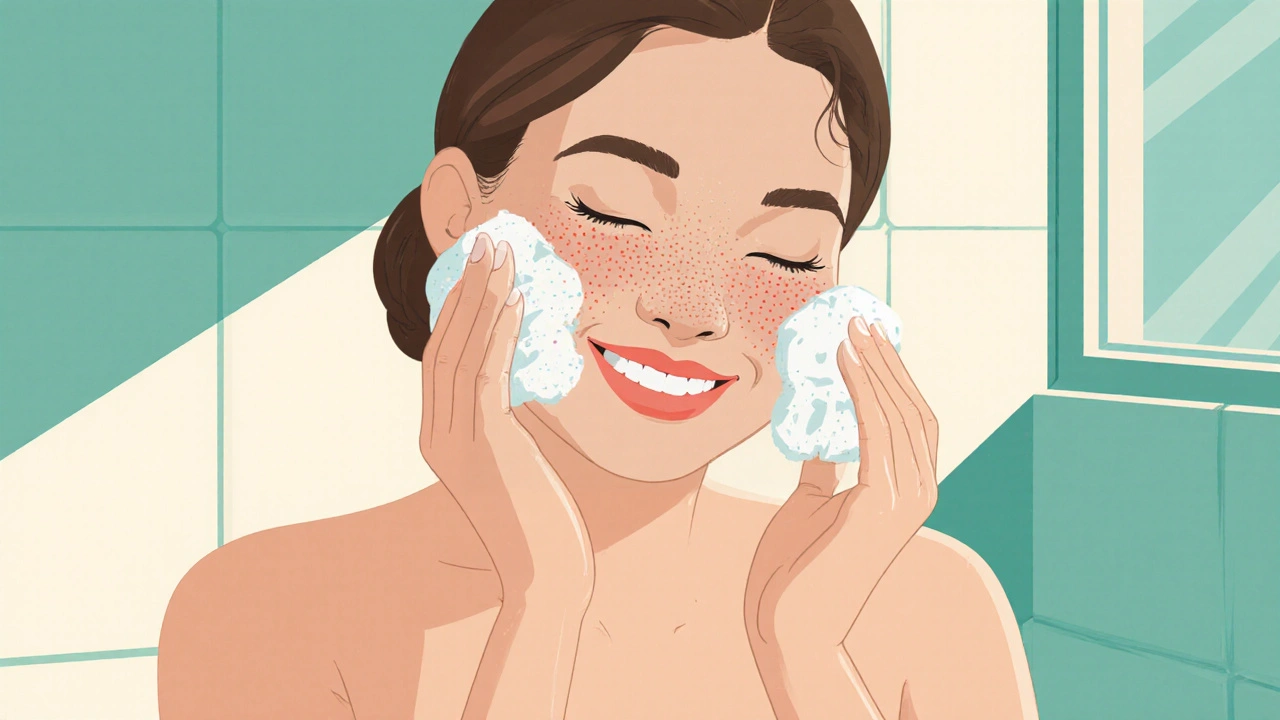Sunscreen Application Calculator
How Much Sunscreen Do You Need?
The right amount of sunscreen is critical for effective protection against UV damage that can darken freckles.
Recommended Application
* This meets the CDC recommendation for full coverage
Want skin that stays glowing while letting your freckles shine? The right skincare routine can protect, nourish, and enhance freckle‑friendly skin without stripping color or causing irritation. Below you’ll find a step‑by‑step guide, product suggestions, and common pitfalls to dodge - all from a practical, everyday‑person perspective.
Key Takeaways
- Freckles need gentle care and consistent sun protection.
- Combine antioxidant serums with a broad‑spectrum SPF in the morning.
- Use mild exfoliation 2-3 times a week and incorporate soothing ingredients at night.
- Choose moisturizers that lock in hydration without heavy fragrances.
- Stick to the routine for at least 4-6 weeks to see lasting results.
Let’s break down why these steps matter and how to execute them.
Understanding Freckles and Why They Need Special Care
Freckles are small, flat patches of increased melanin that appear most often on sun‑exposed areas. They result from a genetic tendency to produce more pigment when UV rays hit the skin, but they are not a sign of damage. While they’re harmless, freckles can darken or become uneven if they’re over‑exposed to UV radiation or if the skin barrier is compromised.
Core Principles of a Freckle‑Friendly Routine
- Gentle cleansing: Use a fragrance‑free, pH‑balanced cleanser to avoid stripping natural oils.
- Consistent sun protection: Broad‑spectrum SPF 30+ is non‑negotiable.
- Antioxidant support: Vitamin C, niacinamide, and hyaluronic acid help even tone and keep melanin stable.
- Controlled exfoliation: Prevents buildup of dead cells that can make freckles look dull.
- Hydration and barrier repair: Moisturizers with ceramides or peptides lock in moisture without clogging pores.

Step‑by‑Step Morning Routine
- Cleanse: Wet your face with lukewarm water, apply a pea‑sized amount of a gentle cleanser, and rinse.
- Toner (optional): Hydrating toner contains humectants like glycerin to add a moisture boost before serums. Pat onto skin with clean hands.
- Antioxidant serum: Vitamin C serum provides 10‑15% L‑ascorbic acid to brighten and protect melanin from oxidative stress. Apply 2‑3 drops and let absorb.
- Moisturizer: Moisturizer with ceramides and hyaluronic acid keeps the skin barrier supple without heavy fragrance. Use a nickel‑size amount.
- Sun protection: Sunscreen broad‑spectrum SPF 30+ containing zinc oxide or titanium dioxide shields UV rays that can darken freckles. Apply at least 1/4 teaspoon to the face and blend well.
Step‑by‑Step Evening Routine
- Double cleanse (if you wore makeup or sunscreen): First with a micellar water, then repeat the gentle cleanser.
- Exfoliate (2‑3 times/week): Exfoliant with 0.5%-1% AHA (like glycolic acid) gently removes dead cells without irritating melanin. Apply to dry skin, leave for the recommended time, then rinse.
- Treatment serum: Niacinamide serum at 5% helps regulate melanin production and reduces redness. Pat onto skin.
- Targeted retinol (optional, 2‑times/week): Retinol promotes cell turnover and can even out freckle intensity when used sparingly. Apply a pea‑sized amount, avoiding the eye area.
- Moisturizer: Same product as morning, but you can layer a richer night cream if your skin feels drier.
Product Recommendations - Quick Comparison
| Product Type | Key Ingredient | SPF (if applicable) | How to Use |
|---|---|---|---|
| Cleanser | Ceramide‑rich, fragrance‑free | - | Morning & night, gentle massage |
| Vitamin C Serum | L‑ascorbic acid 12% | - | Apply after toner, before moisturizer |
| Sunscreen | Zinc oxide 20% | SPF 50 | 2‑4 minutes before sun exposure |
| Exfoliant | Glycolic acid 0.5% | - | 2‑3×/week, leave on 5‑10 min |
| Niacinamide Serum | Niacinamide 5% | - | After exfoliant, before retinol |
| Retinol | Retinol 0.3% | - | Evening, 2×/week, follow with moisturizer |

Tips to Keep Freckles Looking Their Best
- Reapply sunscreen every two hours when outdoors, and after swimming or sweating.
- Wear UV‑protective clothing, hats, and sunglasses on sunny days.
- Avoid harsh scrubs or alcohol‑based toners that can damage the skin barrier.
- Stay hydrated; internal water levels affect surface moisture.
- Schedule a dermatologist check‑up once a year to rule out atypical pigment changes.
Common Mistakes to Avoid
- Skipping SPF because freckles are “natural” - UV rays will deepen them.
- Using high‑strength retinol daily - can cause irritation and uneven pigment.
- Over‑exfoliating - removes protective oils and can trigger inflammation.
- Choosing fragrance‑heavy moisturizers - fragrances may irritate sensitive freckled skin.
- Neglecting nighttime repair - skin works best while you sleep.
Frequently Asked Questions
Can I get rid of freckles completely?
Freckles are a natural pigment pattern. While laser treatments or intense bleaching can fade them, most dermatologists recommend embracing them and focusing on protection instead of removal.
Is chemical sunscreen safe for freckle‑prone skin?
Yes, if it’s a broad‑spectrum formula without fragrance or alcohol. Look for ingredients like zinc oxide or titanium dioxide for a physical barrier that’s less likely to irritate.
How often should I use Vitamin C serum?
Every morning is ideal. Vitamin C oxidizes quickly, so store it in a opaque bottle and apply within 15 minutes of opening.
Can retinol darken my freckles?
When used correctly (low concentration, limited frequency), retinol promotes even turnover and usually lightens dark spots over time. Overuse, however, can cause irritation that temporarily darkens pigment.
Do I need a separate night moisturizer?
If your daytime moisturizer is lightweight, a richer night cream with ceramides or peptides can help seal in moisture while you sleep. Otherwise, the same product works fine.


Liberty Moneybomb
October 18, 2025 AT 17:06Listen up, the skincare elite don’t want you to know that the so‑called “gentle” cleansers are laced with micro‑micro‑particles designed to siphon off your melanin, leaving freckles looking like a pale ghost. They’ve been feeding us chemically‑enhanced SPF that actually accelerates pigment darkening while pretending to protect. The hidden agenda? A massive profit scheme that forces us to buy “anti‑freckle” lasers every other year. Wake up before the next “clinical study” pushes a new “brightening” serum that strips the very melanin you cherish. Remember, every glossy ad is a Trojan horse for the next wave of skin‑science control.
Alex Lineses
October 18, 2025 AT 18:30Hey there, let’s break this down with a bit of science‑backed mentorship. The key is to anchor your routine in barrier‑supportive ingredients-ceramides, hyaluronic acid, and niacinamide-while leveraging photoprotection that meets the broad‑spectrum criteria (UVA/UVB). Think of your skin as a biochemical network: the antioxidant serum mitigates reactive oxygen species, the moisturizer reinforces the lipid matrix, and SPF acts as the external filter node. By integrating these modules consistently for a 4‑6‑week convergence window, you’ll see quantifiable improvements in melanin stability and erythema reduction. Stay consistent, monitor your skin’s response, and adjust the exfoliation frequency based on barrier feedback.
Brian Van Horne
October 18, 2025 AT 19:53Your routine aligns with the ceramide cascade paradigm.
Norman Adams
October 18, 2025 AT 22:40Ah, the “Freckle‑Friendly Products” table-what an avant‑garde masterpiece of dermatological minimalism. One can barely contain the excitement over a 0.5% glycolic acid exfoliant that promises to “leave on 5‑10 min,” as if we all have the luxury of a perfectly timed bathroom schedule. And the coveted zinc‑oxide SPF 50, the holy grail of sun defense, is listed with the reverence of a relic, though we all know the market is saturated with identical formulations masquerading as innovation. Truly, this guide redefines the art of stating the obvious in a table format.
Margaret pope
October 19, 2025 AT 00:03Totally get it we all need real info not fluff and the table does help keep things clear and simple
Karla Johnson
October 19, 2025 AT 02:50When it comes to cultivating a freckle‑friendly complexion, the conversation must start with an appreciation for the delicate balance between melanin production and barrier integrity. First and foremost, one cannot overstate the importance of a pH‑balanced cleanser that respects the skin’s innate acid mantle, because any disruption here triggers a cascade of inflammatory mediators that can exacerbate pigment irregularities. Second, the morning antioxidant serum, particularly one anchored by L‑ascorbic acid, serves not merely as a brightening agent but as a potent scavenger of free radicals generated by UV‑induced oxidative stress, thereby preserving the uniformity of existing freckles. Third, the role of hyaluronic acid, when layered beneath a ceramide‑rich moisturizer, is to create a hydrated matrix that prevents transepidermal water loss, a critical factor in maintaining epidermal homeostasis and preventing compensatory hyperpigmentation. Fourth, sunscreen is non‑negotiable; a broad‑spectrum SPF 30+ formulation that incorporates mineral filters such as zinc oxide offers a physical barrier that reflects and scatters ultraviolet photons, protecting melanin from further photochemical alteration. Fifth, controlled exfoliation with a low‑percentage AHA, applied no more than three times per week, facilitates the removal of keratinous debris that can otherwise trap melanin in the superficial layers, leading to a dull appearance. Sixth, the inclusion of niacinamide at a 5% concentration works synergistically with antioxidants to modulate the activity of tyrosinase, the enzyme responsible for melanin synthesis, thereby preventing the formation of new hyperpigmented spots. Seventh, retinol, when used judiciously-preferably at a concentration below 0.5% and limited to twice weekly-accelerates cellular turnover without compromising the skin barrier, allowing for a more even distribution of pigment across the epidermis. Eighth, nightly nourishment with a peptide‑enriched night cream supports collagen synthesis, which not only improves skin firmness but also provides a scaffold for uniform melanin dispersion. Ninth, lifestyle factors such as adequate hydration, a diet rich in antioxidants, and regular physical activity contribute systemically to skin health and should not be overlooked. Tenth, consistent reapplication of sunscreen throughout the day, especially after swimming or heavy perspiration, reinforces protection against cumulative UV exposure. Eleventh, protective clothing-wide‑brimmed hats, UV‑filtering sunglasses, and UPF‑rated garments-serves as a secondary line of defense, reducing the total UV load on freckle‑prone areas. Twelfth, periodic dermatological assessments enable early detection of atypical pigment changes, ensuring timely intervention should any dysplastic lesions arise. Thirteenth, one must avoid harsh physical scrubs and alcohol‑based toners that strip lipids and compromise the barrier, as these practices invariably lead to irritation and subsequent pigment instability. Fourteenth, it is essential to give the regimen at least a month before judging efficacy; skin remodeling is a gradual process that demands patience. Fifteenth, tracking progress with a simple photographic log can provide objective evidence of improvement and motivate adherence to the protocol. Finally, the overarching principle is to treat freckles not as flaws to be eradicated but as natural variations to be celebrated, all while protecting them from the relentless assault of ultraviolet radiation.
Stephanie Zaragoza
October 19, 2025 AT 04:13Indeed; your comprehensive schema is methodical, evidence‑based, and meticulously sequenced; however, a few clarifications merit emphasis: the suggested AHA concentration should not exceed 0.5% to avert barrier compromise, and the niacinamide dosage, while efficacious, must be balanced against potential transient flushing in sensitive phenotypes; also, retinol frequency ought to be incrementally titrated-starting at once weekly before progressing to bi‑weekly applications-to mitigate erythema; finally, documenting outcomes via standardized photographic parameters (lighting, angle, distance) will bolster data reliability.
Janet Morales
October 19, 2025 AT 07:00All this “gentle” routine nonsense? It’s a sham orchestrated by the beauty industry to keep us buying endless bottles while pretending we’re preserving our freckles. You can slap on SPF and call it a day, but the real answer lies in embracing the sun, letting those freckles deepen, and rejecting the corporate narrative that tells us we need to “protect” our natural pigments. The moment you stop feeding the market’s fear‑mongering, you’ll realize that nothing about this guide is revolutionary-just a rehash of hype.